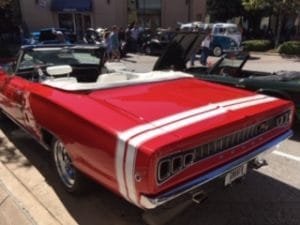Featured is a sleek 1968 Dodge Coronet R/T Convertible. This is an automobile that Dodge built during the prime years of the late 1960’s muscle car era. Some referred to the latter 60’s and very early 70’s as the American Performance Generation. Everything seemed to be about fast cars and top performance.

To be sure, the muscle car era offered buyers a very large choice of automobiles ever since the Pontiac GTO, Ford Mustang and Chevy Camaro came out. Virtually every major automaker produced an entry.
The Long Life of the Coronet Model
The Dodge Coronet has been around ever since the late 1940’s. One of the first new offerings from Dodge following World War Two. The Dodge Coronet had a very impressive seven generation production run from 1945 to 1976.
The 1950’s saw many improvements and restyling that at one time put it’s overall length at 217 inches.
The Coronet model wasn’t produced for a short period during the early 1960’s but came roaring back in 1965, this time as an intermediate model. With one base and two deluxe Coronet models it was the highest selling Dodge automobile for the 1965 model year.
The car was part of Coronets fifth generation which ran from 1965 to 1970.
The Dodge Coronet for the 1968 model year was a newly designed automobile. The car had a more attractive design with most of the credit being attributed to Richard Sias and his team, a designer hired away from General Motors. Sias’ styling for the 68 Coronet was so well received by that aspects of it went into the 68 Dodge Charger. In addition to that the Plymouth division copied aspects of the design for it’s lineup.
Dodge Coronet models for 1968 included the Coronet Deluxe, Coronet R/T. Coronet 440, 550, and in mid year the Coronet Super Bee.
The Richard Sais story at Dodge is quite interesting. His design team went ahead and came up with new 1968 Dodge Charger restyling designs even against the orders of Dodge chief designer William Brownlie. In fact, Brownlie had the Sais double-diamond clay model for the Charger destroyed. The double-diamond Charger side had a Coke-bottle appearance. Many call it the Coke-bottle Charger.
The Sais team went ahead nevertheledd at the direction of of their immediate superiors. Brownlie it’s noted wanted to go in an entirely different direction with the Charger styling. When Brownlie, returned from a vacation, he was not happy at all when he learned about the double-diamond team design but changed his tune quickly when told it looked great by Elwood Engel, the design chief for Chrysler Corporation. That restyling for 1968 turned out to be a huge success and propelled the Coke-bottle Charger model into the design history books.
As things turned out, Richard Sais left the Chrysler Corporation in 1968 after it was learned Brownlie began taking credit for the Sais Charger restyling. It’s reported that Sais left automobile design altogether because of the internal politics.
1968 Dodge Coronet R/T Specifications
The 1968 Dodge Coronet was available with one inline six engine and ten variously configured V-8’s. That’s plenty of engine options for sure.
 The standard inline six delivered 101 HP. The V-8’s had displacements of 273, 318, 340, 383, 426, 440. Within the V-8 group horsepower ranged from 180 to 425.
The standard inline six delivered 101 HP. The V-8’s had displacements of 273, 318, 340, 383, 426, 440. Within the V-8 group horsepower ranged from 180 to 425.
The Dodge Coronet R/T had a 440 Magnum V-8 as standard equipment since R/T was introduced. Asa an option you could order a 426 Street Hemi.
Available transmissions for the Coronet R/T were a four speed manual and a three speed TorqueFlite automatic.
Total 1968 production for Dodge was 625,000 vehicles. Out of that number about 190,000 were Coronets.
Dimensions for the 68 Coronet included a wheelbase of 117.0 inches, overall length 207.0 inches and width 77.0 inches.
Weight for the 68 Coronet R/T Convertible was 3,650 lbs. The Convertible new car price was about $3,600.
Two models were available with the 68 Coronet R/T. These were a two door sport coupe and a convertible.
See related Auto Museum Online articles found on the links below..
1958 Dodge Coronet Lancer Coupe
Reference material for this article includes..Dodge and Plymouth Muscle Cars by Peter Sessler..Hemmings Motor News..The Great American Convertible by The Auto Editors of Consumer Guide.
1968 Dodge Coronet R/T Collector Popularity
As mentioned above you’ll find the 68 Coronet R/T in only a two door sport coupe and convertible models.
The 1968 and 1969 Cornet R/T’s are very popular among collectors and enthusiasts. Currently asking prices for restored examples in excellent condition appear to start in the $60,000 plus area and go upwards in price from there.
(Article and photos copyright Auto Museum Online)


